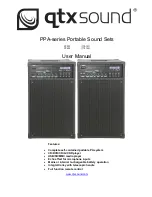
ADSP 8
26
26
GEQ / PEQ Mode:
This is a switch button for parametric equalizer mode and graphic equalizer
mode, cllick and pop-up a dialog. Press “YES” button switch to equalizer pattern.
The difference between Graphic (GEP) and parametric equalizer (PEQ) is as
follows:
(1) Graphic Equalizer:
also called graphic equalizer, the distribution of the
push-pull button on the panel, can intuitively reflect the adjusted isostatic
compensation curve, the ascension of each frequency and attenuation condition
that must be clear at a glance, which adopts the technology of the constant Q,
each frequency point is equipped with a push-pull potentiometer, regardless of
ascension or a frequency attenuation, the fulted band width is always the same.
The commonly used professional graphic equalized is 20Hz to 20 kHz signal
which is divided into 10-band, 15-band, 27-band, 31-band to adjust. So you can
choose different bands frequency equalizer according to your different
requirements. Generally 10-band equalizer fequency points to octave interval
distribution, used in general cases, 15-band equalizer is 2/3 octave equalizer. For
professional amplification, 31-band equalizer is 1/3 octave equalizer. Usually at
the most important fine compensation cases are, the ghaphic equalizer structure
is simple, intuitive and clear, therefore, it is widely used in professional audio.
(2) Parametric Equalizer:
also called parametric equalizer. It can adjust
various parameters with precision. Mostly attached on the tuning table, but it also
has an independent parametric equalizer. The adjusting parameters include
frequency, gain and quality and quality factor Q value, etc., that can make the
voice prettier or uglier, changing it, make a sound or music style fresher. Colorful
and bright highlights to meet with the artist’s needs.
10.5.5. Status Bar Signal Input
The audio source status bar displays the current signal input source.
















































